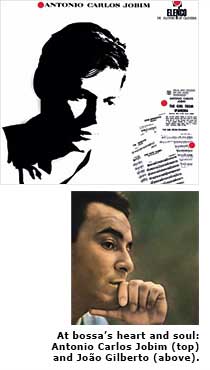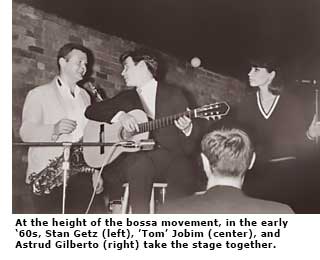Bossa Nova: Music of Modern Love
 "Popular music comes and goes," Antonio Carlos Jobim told us from his Rio de Janeiro home in 1993. "It has vogues," he said, speaking with the broad vowels of his native Portuguese. "Things appear and disappear."
"Popular music comes and goes," Antonio Carlos Jobim told us from his Rio de Janeiro home in 1993. "It has vogues," he said, speaking with the broad vowels of his native Portuguese. "Things appear and disappear."
'Tom' Jobim's words sounded a bit like a lilting lyric from one of hundreds of bossa nova tunes he penned until his passing, in 1994. They also sounded markedly, and characteristically, modest.
Far from being a vogue, the bossa nova which Jobim helped create went on to form "the biggest revolution we had in music in Brazil," in the words of Caetano Veloso, one of that country's current superstars.
In the four decades since its heyday, bossa nova never faded away. It has found a permanent place in the repertoires and hearts of musicians and fans all over the world, and in the United States in particular. Like the best of what was happening in home design at the time of bossa nova's birth a half-century ago, the music has continued to inspire good taste and to affirm the bright lightness of being.
As in mid-century modern America, Brazilian culture moved into a fertile period following World War II, particularly after the mid-1950s. "Our generation was a special generation," says Hélcio Melito, who at that time had relocated from his native São Paulo to Rio, on his way to becoming a seminal percussionist.
"Everybody think to create something new," he continues in idiosyncratic English, from his current venue in Pebble Beach, California. "In soccer [on the way to Brazil's first World Cup victory, in 1958], in other sports, in culture, in theater, in poems."

Melito could easily have added architecture, particularly with regard to Brazilian modernist architect Oscar Niemeyer, who had designed the Manhattan headquarters for the United Nations after the War and was appointed by left-wing Brazilian president Juscelino Kubitschek in 1956 to help create Brasilia, a new capitol city.
There was progressive activity also in theater and film. Poet Vinícius de Moraes, also in 1956, forged a musical theater setting of the Greek myth of Orpheus in the black slums of Rio, which three years later evolved into an award-winning film, 'Black Orpheus,' and inspired the production of more quality films by Brazilians.
Bossa nova was the most prominent genus of Brazilian music during this period, but it had evolved from long, strong roots, extending back to the arrival of Portuguese explorers in 1500 and the first of the African slaves a few decades later. Different musical instruments, melodic forms, and rhythms came from these two sources, ultimately cross-fertilizing, as did their people.
The musical melding accelerated in the 20th century, carried by phonograph and radio to the increasing populations of Brazil's cities. Rio perhaps deserves the most credit for the variegated development of samba, apparently named for a navel-touching dance from Angola (which shared Brazil's Portuguese colonial tradition). The late 1920s witnessed the institution of 'escolas de samba,' or samba schools, which came to dominate, and compete in, Rio's annual pre-Lenten Carnaval parade, with a large and loud battery of cross-cultural percussion.

Powerful, rhythmically complex sambas were created (and rehearsed) in the escolas, located in the hillside slums, called favelas. These sambas attracted a broad range of Brazilians and tourists, but were pretty much confined to the Carnaval celebrations. More-affluent Cariocas (Rio residents) favored sophisticated samba-canções, which showcased melody and lyrics and got year-round radio play.
The radios, phonographs, and concert halls of middle-class Brazilians in the mid-1950s were also tuned to sounds from the other side of the equator, including the seductive, conversational singing style of Frank Sinatra. Those with jazz taste became aware of the breezy but sophisticated approach of the West Coast 'cool school' of jazz [see our coverage in the summer '06 'CA-Modern']. Equally alluring were the sparkling, close vocal harmonies of groups like the Four Freshmen, the Merry Macs, the Starlighters, the Mel-Tones, and later, the Hi-Los.
An aspiring Rio vocal group, Os Garotas da Lua (Boys of the Moon), recruited 19-year-old João Gilberto to move south, in 1950, from his home in the tropical northern state of Bahia, where he'd learned to sing and play guitar. A couple of years later, Gilberto was off on his own, recording samba-canções in a somewhat affected, vibrato-based manner quite different from what he'd become known for a half-dozen years later.




